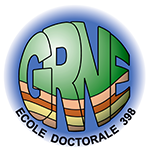Séminaire ISTeP - Margaret Hartley
(Manchester)
Through a glass, darkly? The melt inclusion window into pre-eruptive magmatic volatile contents.
Olivine-hosted melt inclusions (MI) have long been exploited for their capacity to retain information on a magma's history, including information about the pre-eruptive volatile contents of their carrier melts. However, melt inclusions are prone to post-entrapment modification by a range of processes, so that the inclusions may no longer accurately reflect the volatile contents of the melts from which they were trapped. Firstly, post-entrapment crystallization onto the inclusion walls both raises the volatile concentration in the remaining melt and modifies the volatile solubility, which may lead to the formation of a vapour bubble. Secondly, the host olivine is permeable to fast-diffusing elements such as hydrogen, so the inclusion's ability to retain its initial H2O content is diffusion-limited. Thirdly, fracturing and decrepitation of inclusion-hosted bubbles during rapid ascent may result in the loss of volatiles, particularly CO2, from the melt inclusion system.
In this talk I will explore the role that post-entrapment processes have played in modifying melt inclusion volatile contents from the 1783 Laki eruption, Iceland. While diffusive processes have overprinted much of the initial H2O heterogeneity in the primary melts supplied to the Laki system, olivine-hosted melt inclusions from tephra samples are reliable archives of the pre-eruptive H2O content at the final pressure of melt equilibration and storage. Most melt inclusion CO2 contents have been significantly modified by the formation and decrepitation of vapour bubbles. However, melt inclusions trapped at high pressures that experienced a long cooling path are less susceptible to decrepitation. Numerical models also suggest that melt inclusions that enclosed vapour bubbles together with the melt (i.e. heterogeneously trapped inclusions, often avoided in melt inclusion studies), are better able to preserve the melt CO2 content during decompression and post-entrapment crystallization than melt-only inclusions under equivalent conditions. Thus, by selecting appropriate samples and unravelling the effects of post-entrapment modification, it is possible to see through the 'dark glass' to access the diversity of pre-eruptive volatile contents in subvolcanic melts.
22/09/2017, Salle Fourcade à 12h30
Chiffres clés (Mars 2025)
L'ISTeP comprend 131 membres dont :
Permanents (66)
- Professeurs : 17 (+2 PAST)
- Maîtres de conférence : 26
- Directeurs de recherche CNRS : 1
- Chargés de recherche CNRS : 1
- ITA : 19
Personnels non permanents (65)
- Collaborateurs bénévoles / émérites : 17
- Chaire de professeur junior : 1
- Enseignants-chercheurs contractuel : 2
- 1 MCF accueil en délégation
- ATER et Post-Docs : 9
- Doctorants : 32
- ITA-BIATSS : 3





